The Cotswolds is one of UK’s Areas of Outstanding Natural Beauty, stretching over six different counties. A few weekends ago I took advantage of the gorgeous weather and decided to visit the Cotswolds on an extended road trip, for the first time. This is how the Cotswolds itinerary (below) was born. It took me a while to compile everything into just one post, but I do hope you will find it helpful, and it gives you some useful ideas for when you plan your perfect trip to the Cotswolds by car. And I highly recommend that you do go on a road trip around the Cotswolds, because the public transport is not that reliable. If you are visiting England, renting a car from the airport for a weekend won’t cost as much as you might think, and it is so worth it if you want to have independence and not rely on bus timetables. You can check for cheap car rentals on Holiday Extras. I always book my rental cars through them when I travel because they show all the costs upfront.
A road trip through the Cotswolds is the best way to explore this beautiful region at your own pace, enjoying cream teas at independent tea houses and fresh lunches, made with locally sourced ingredients, at family owned restaurants. Strolling around the Cotswolds couldn’t be more relaxing, with picture-perfect moments around every corner.
When you think about the Cotswolds, honey-coloured limestone houses lined up on narrow streets, surrounded by rolling hills, come to mind. But the Cotswolds is so much more than this. In this Cotswolds itinerary I will show you how to experience the most beautiful villages in a local way, exploring off the beaten path locations, see the best preserved churches in England, supporting small businesses by eating and drinking in ancient pubs, and much more.
Are you ready? Let’s go on a road trip to the Cotswolds!
Where to Stay When You Visit the Cotswolds
There are so many places to stay in the Cotswolds, from beautiful B&Bs in small stone houses to big, luxurious manors with spas, which do come at a price though.
As I travelled to the Cotswolds on a budget, I decided to stay in the nearby town of Gloucester, which is ideally located between the North and the South of the Cotswolds. I booked the Ibis Hotel for £76/2 nights, which included parking. This also gave me the opportunity to explore Gloucester on the Friday, after my drive from London.
You can check out the reviews of Ibis Gloucester on Tripadvisor, or book directly on Booking.com
A Perfect Cotswolds Itinerary
In this Cotswolds itinerary I have gathered together a list of all the villages I visited, in perfect order, to explore by car. Some of the villages get very crowded, especially during the weekend, so you need to visit them first thing in the morning, even if it means driving a bit out of your way.
Besides the activities I will recommend for you to do in each village, do take the time to stroll around and explore the surroundings. The beauty of the Cotswolds is in the limestone architecture, the narrow streets and the flower gardens. Enjoy!
Day 1:
Bourton-on-the-Water
Often referred to as the Venice of the Cotswolds, Bourton-on-the-Water is one of the most beautiful villages in the Cotswolds but, at the same time, one of the most popular. This is why I highly recommend visiting Bourton-on-the-Water as early as possible and make it your first stop in your Cotswolds itinerary. There isn’t a lot of parking spaces in Bourton-on-the-Water either, so by arriving early you won’t lose time going in circles trying to find somewhere to park.
Where to park: The car park in Bourton-on-the-Water is located on the High Street, as you come from the main A429 road. Parking here is free but limited to one and a half hours. Alternatively, check out the Station Road Car Park, which costs £3/day.

Things to do in Bourton-on-the-Water:
- The Model Village is a miniature representation of the village, how it used to look like in 1930. The village is one-ninth of its full scale and it’s quite entertaining to walk through, especially when you take pictures and compare it with the actual buildings. This is especially entertaining for children. A ticket to the Model Village costs £4.25 for adults and £3.25 for children
- The Motor Museum is home to a collection of old, rare cars, motorbikes and caravans. The museum also hosts a large toy collection which will bring back a lot of memories to many of us. A ticket to the Cotswolds Motor Museum costs £6.50 for adults and £4.60 for children. Kids under the age of 8 benefit from a free entrance.
- Birdland Park and Gardens is home to over 500 different bird species, among which exotic specimens such as pink flamingos, penguins, parrots and birds of prey. A ticket to explore the park costs £9.95 for adults and £6.25 for children.
- Walk the Warden’s Way, a path that starts in Bourton-on-the-Water and goes to Winchcombe, passing through picturesque villages such as Lower and Upper Slaughter, Naunton and Guiting Power. If you don’t have time to walk the entire 14 miles, the 1.6 miles (40 minutes) walk to Lower Slaughter will give you a glimpse of what exploring the Cotswolds countryside by foot, along the river, looks like.
Where to eat/drink: I arrived in Bourton-on-the-Water around 10am and to my surprise, all the coffee shops along the waterfront were either full, or were asking if I had made a reservation. Walking a little bit out of the touristy area, I stumbled upon a small café with four tables outside, one of which was free. The owner was very happy to accommodate me at one of the free tables on the terrace, and I was happy to have breakfast there. The food was very good, the prices decent, and the staff super friendly, so I do recommend A’moore Coffee House as an alternative to the super busy cafes near the river.
Moreton-in-Marsh
Moreton-in-Marsh is a lovely market town that you shouldn’t miss during your Cotswolds itinerary, especially as it is not as crowded as other villages. The High Street in Moreton-in-Marsh is lined with beautiful buildings dating from the 17th and 18th century, which are now used as shops, restaurants, cafes and hotels.
Where to park: There are a few free parking spaces just after the Manor House Hotel, on both sides of the road. I didn’t notice any parking restrictions such as time limit or no return within a certain time frame.
Things to do in Moreton-in-Marsh:
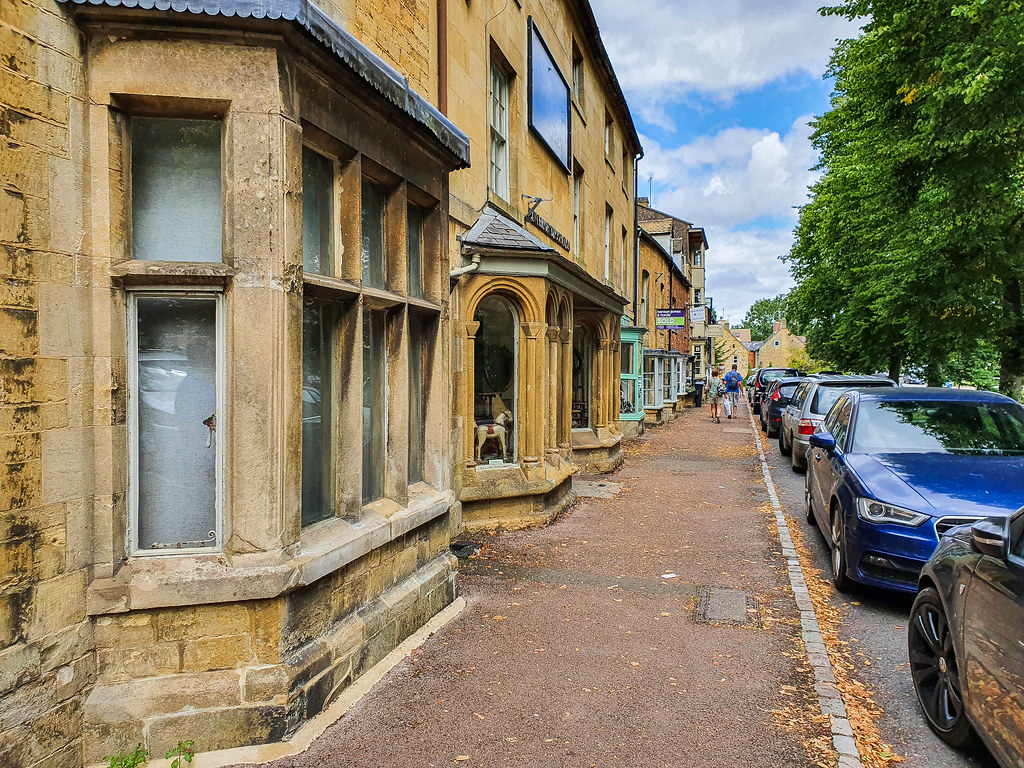
- If you happen to visit Moreton-in-Marsh on a Tuesday, then checking out the weekly market is a must. You will find all sorts of things sold here, from local fruits and vegetables to clothes and handmade items.
- The White Hart Hotel is worth a quick stop, even if only to look at from the outside. This is where King Charles I sheltered during the English Civil War, after the battle of Marston Moor in 1644. Fun fact, the king did not pay his bill, which is displayed on a plaque at the entrance lobby.
- The Curfew Tower is believed to be the oldest building in Moreton-in-Marsh, dating from the 16th century. Located on the High Street, the role of the tower was to ring the bell each night, to remind the villagers of the risk at fire.
- Cotswold Falconry Centre is home to over 60 species of birds, some of them critically endangered in the wild. Here, youngsters can enjoy daily demonstrations and learn about the behaviour of a bird of prey. The ticket fee for Cotswolds Falconry Centre is £12 for adults and £6 for children.
- Batsford Arboretum has the country’s largest private collection of shrubs and trees. The 56-acre garden is dog friendly, has a plant nursery for gardening enthusiasts and a lovely café with home-baked food. The ticket price is £8.95 for adults and £3.50 for children.
- If you are a Lord of the Rings fan, you much check out the Four Shire Stone, just on the outskirts of Moreton-in-Marsh. It is believed that this stone, which sits at the crossroads between Gloucestershire, Warwickshire, Worcestershire and Oxfordshire, was the inspiration for the Three-Farthing Stone in Lord of the Rings. J.R.R. Tolkien was a frequent visitor of Moreton-in-Marsh and liked to drink at the Bell Inn, which inspired The Prancing Pony pub at Bree, in the famous fantasy book.
Where to eat/drink: The Yellow Brick bistro serves delicious fresh homemade food, made with locally sourced ingredients, and they offer great value lunch deals. Their menu also includes local drinks such as Cotswolds gin and craft beer. The outside terrace is lovely, especially when the weather is sunny and warm.
Broadway
Broadway is known for its honey coloured 16th century limestone Georgian buildings which line up the main “broad way”, from which the village gets its name.
Where to park: A good place to park with plenty of spaces is the Short Stay Car Park, just off Church Street. When I visited Broadway, the parking was free of charge, but there were ticket machines there, so I assume that it was just a temporary measure. Usually the maximum stay is 4 hours, and the charge is £3.
Things to do in Broadway:

- The Broadway Tower is the second highest point in the Cotswolds, at 1,024 feet above the sea level, and it is said that on a clear day you can see the landscape stretching to the horizon for miles. Unfortunately, when I visited the access was restricted due to a wedding, so I was unable to get too close.
- During the years, Broadway has attracted many famous artists such as Claude Monet, Oscar Wilde, John Singer-Sargent, Edward Elgar, and William Morris. As an inspiration for many artists, both local and American, the Broadway Group of Artists was created, back in the 1880s. The Museum and Art Gallery hosts many of the works that these artists created during their time living in Broadway, inspired by the beauty of the village and the surrounding countryside. An adult ticket to visit the Museum and Art Gallery costs £5, whilst a child’s ticket is £2.
- Visit the Snowshill Manor and Gardens, just 15 minutes from the village, for a fascinating introduction to the world of Charles Paget Wade. His eclectic collection includes furniture, paintings, costumes, musical instruments, and many other designer objects. He was so obsessed with his collection at the Snowshill Manor that he chose to live in a cottage in the garden rather than disturb anything in the big house. Snowshill Manor and Gardens belongs to the National Trust, so if you are a member, entrance is free. Otherwise, an adult ticket costs £8, whilst a child’s ticket is £4.
- The Design Museum showcases 60 years of the innovative work of the well-known furniture designer Sir Gordon Russell. Located in his old workshop, a grade II listed building, the museum follows his footsteps and tells his life story. The ticket for the Gordon Russell Design Museum cost £5 for adults. Entrance is free for children under 16 years old.
- If you visit Broadway in June, July or August, you must stop at the Cotswolds Lavender Farm for a few photos for Instagram, and a nice walk along the purple fields. You can also visit their distillery, to see how they make essential lavender oil. The fee to visit the lavender farm is £2,50 for adults and £1.50 for children.
Where to eat/drink: I found Broadway to have expensive restaurants, especially compared with other villages I visited before. I checked the menus at many different restaurants located on the main street in the village, and they were all pretty expensive. Don’t get me wrong, I do appreciate good food, but to pay £20 for a burger? – it has to be a damn good burger! However, walking away from the main road I stumbled upon The Crown & Trumpet Inn, a traditional pub with friendly staff, where I was able to enjoy a delicious lunch for less than £7 in their lovely beer garden.
Blockley
Blockley is a quiet sleepy Cotswolds village with not much to do, other than just walk around and admire the beautiful golden limestone buildings. Blockley is a charming village where everyone seems to know everyone else, and where locals say hello to you when you pass by each other on the street. There is only one small shop and one pub in the village, The Great Western Arms, making Blockley a great base if you are searching for a place away from the hustle and bustle of the big cities.
Where to park: There are only a few parking spaces, across from the pub, and near the church. Beware, Blockley is a hilly village with some very steep roads.
Things to do in Blockley:

- The Garden at Mill Dene is a very quaint place to visit. The mill was bought in 1964 by the Dene family. They started to transform the garden at the beginning of the 1990s, opening it up to the public for the first time in 1992. The trail around the garden takes 1.5 hours and offers beautiful views over the valley below. PS, there’s even a waterfall! An adult ticket to visit the Mill Dene Garden costs £8, whilst a child’s one is £4.
Where to eat/drink: Not much of a choice, with only one pub in the village. Head over to the Great Western Arms for a hearty dinner and a drink with the locals.
Bourton-on-the-Hill
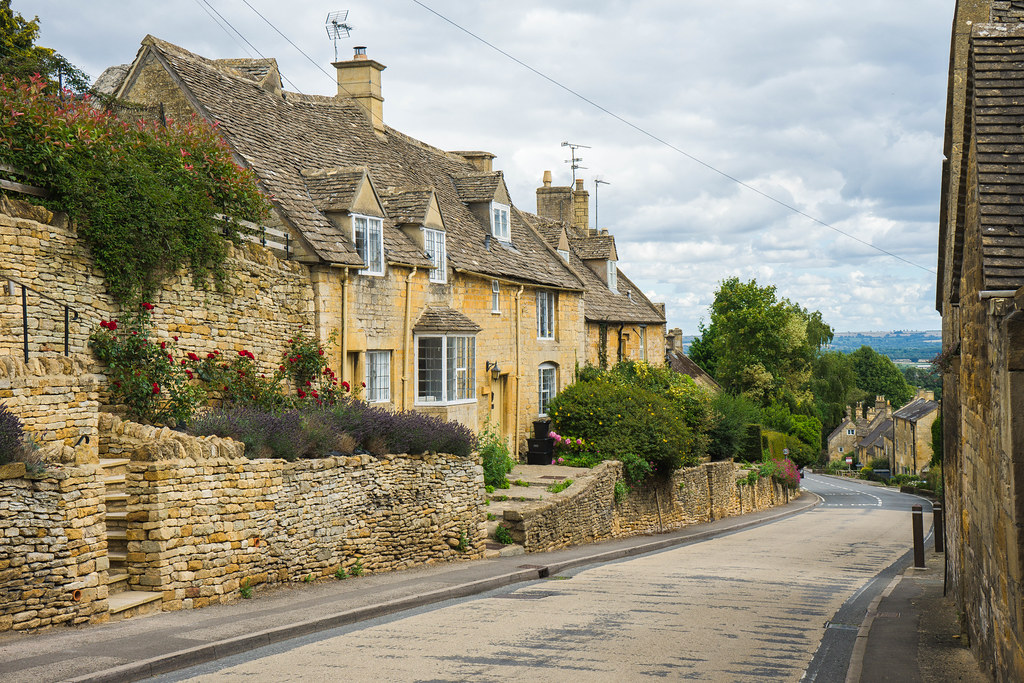
Bourton-on-the-Hill, as the name suggests, is located on a hill, offering beautiful views over nearby Moreton-in-Marsh and the valley below. Walking around Bourton-on-the-Hill can be a challenge because the hill is very steep.
Where to park: There is a small parking area at the bottom of the hill, near Bourton House Garden. I parked in one of the side streets behind the church, as I missed the main village parking.
Things to do in Bourton-on-the-Hill:

- The Bourton House Garden is a perfect example of a Garde I listed 16th century Tithe Barn. The garden around it is a luxuriously terraced landscape, with topiaries, a raised basket pond and creative planters. The ticket price for adults is £8, children under 16 years old benefit of free entry.
- A few minutes’ drive out of the village, you will stumble upon Sezincote House, an odd Indian Moghul style mansion in the middle of the Cotswolds. It is set in a beautiful water garden and even has a temple dedicated with Surya, the Hindu God of the Sun. The ticket to visit Sezincote house cost £7.5 for adults and £2.5 for children.
Where to eat/drink: Just like nearby Blockley, Bourton-on-the-Hill only has one pub, so there isn’t much variety when it comes to eating. The Horse and Groom sits at the end of the village, on the hill, offering traditional dishes with locally sourced ingredients. The views from the garden are totally worth the visit, even if it’s just for a drink.
Stow-on-the-Wold

Stow-on the-Wold used to be known for its huge annual fairs, where shepherds from all over the UK would sell their sheep, sometimes up to 20,000 a day. Stow-on-the-Wold bears a historical significance, as it was the place of the last battle of the English Civil War, in 1646. Standing at the crossroads of eight different roads, the town played a very important role in the movement of the troops, during the war.
Where to park: There is a large free car park right next to Tesco Superstore, just outside the town centre. Make sure you park in the free parking though, and not at Tesco.
Things to do in Stow-on-the-Wold:

- With so many antique shops, art galleries and craft stores, Stow-on-the-Wold is a great place to go shopping for something unique for your house, or for handmade souvenirs and gifts.
- Walking around town, you will stumble upon many narrow alleys. These are called “chures” and were used to herd the sheep into, and count them easily.
- St. Edward’s Church which stands in the middle of the Market Square is famous for its stained-glass windows and it’s three framed doorway. The church was built between the 11th and the 15th century.
- Every second Thursday of the month, the Farmers Market is held in the Main Square. Local farmers/growers come to sell their produce to both residents and tourists.
Where to eat/drink: I chose to stop at the Kings Arms, a small old pub with character and an outside terrace. I only had a drink here, and sat outside, enjoying the view of the main square in Stow-on-the-Wold. For dinner, check out Old Buckers, on Park Street. The food looked fantastic.
Lower Slaughter

It’s much better to visit Lower Slaughter as the last destination of the day, to avoid the crowds. The village is tiny but so beautiful and picturesque, that you will want to have it all to yourself. The traditional limestone cottages on both sides of the river culminate with the view of the old mill and its original water wheel, which is still functioning. Lower Slaughter is also home to the most romantic street in Britain, voted in a poll created by Google Street View, in 2011.
Where to park: There are a few free parking spaces on Copsehill Road, opposite the Slaughters Manor House. Parking is very limited so you either arrive early/late in the day, or park in Bourton-on-the-Water and walk to Lower Slaughter.
Things to do in Lower Slaughter:

- Visit the Old Mill Museum, where you will learn about the process of flour and grist milling with the help of water and stones, and see the original machinery dating from the 18th century. The mill is also a tea house, producing their own organic ice cream, so if not for the museum, it’s worth stopping by for a cup of tea and a cold dessert.
Where to eat/drink: Have a drink at the Slaughter’s Country Inn, or even dinner if it’s that time of the day. The outside terrace is breath-taking, especially because you can take your drink and sit on a bench by the river. Isn’t that romantic?
Day 2:
Painswick

Painswick is a historic wool town in the Cotswolds, very picturesque and tranquil. Also known as “The Queen of the Cotswolds”, Painswick was recently the filming set for BBC’s “The Casual Vacancy”, by J.K. Rowling.
Where to park: There is a medium sized car park near the church, just off New Street. Stamages Lane Car Park is very reasonable priced, with 40p an hour, capped at £2.50 for 5+ hours. Sundays is free of charge.
Things to do in Painswick:
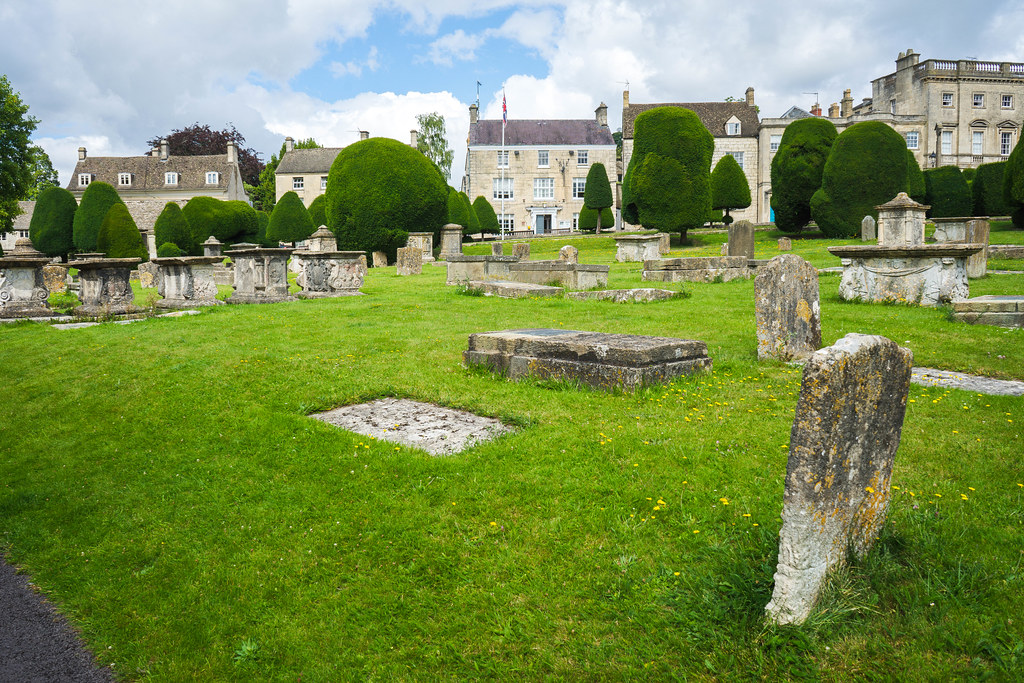
- The church of St. Mary is famous for its 99 yew trees in its garden. The legend says that 100 were planted, but one of them didn’t grow. Every time there is an attempt to plant the 100th tree, it dies. In the churchyard there are also some unusual tombs which resemble tabletops. The church itself is also quite spectacular, built between the 14th and the 16th century, with a dramatic spire which was added in 1632.
- The New Street in Painswick is not that new at all. It was built in the 15th century and is home to the oldest building in England to hold a Post Office, which unfortunately is now closed. It is the only building in Painswick with exposed timber framing.
- The Painswick Rococo garden dates from the 18th century and features seasonal flowers and vegetable plots. It’s a unique quirky garden, the only one in the Rococo style in the country. A ticket to visit the Rococo garden costs £10 for adults and £4.60 for children.
Where to eat/drink: The Royal Oak is a cosy country pub which serves delicious food made with locally sourced ingredients. It also has a good selection of local ales. The staff were very friendly too.
Nailsworth

Nailsworth is a quiet artistic village, worth stopping at for a quick look, a good English breakfast, and beautiful river views.
Where to park: There is a large free parking area on Old Market street, just above the town centre.
What to do in Nailsworth:
- There isn’t that much to do in Nailsworth, other than walk around and explore the town. The Church of St. George is an imposing building, overlooking the town.
Where to eat/drink: The Egypt Mill Hotel and Restaurant serves a fantastic breakfast in a superb location, by the river. It is a hotel, but they do serve outside guests as well. I can imagine that dinners here are special as well, because of their privileged location.
Castle Combe
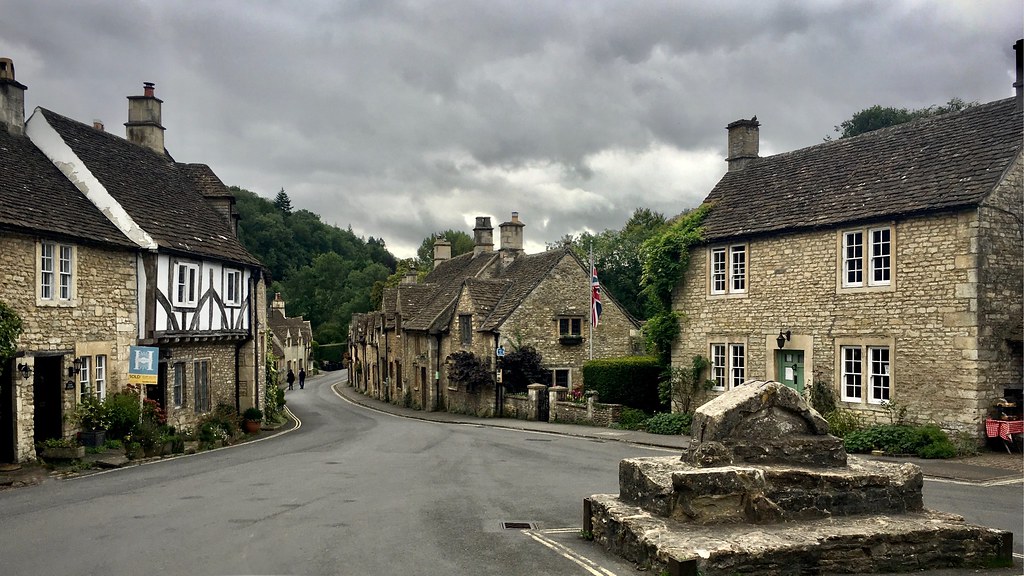
Castle Combe is without a doubt one of the most beautiful villages in England and unless you visit it early in the morning, you will unfortunately encounter crowds of people. Castle Comb is in the Southern part of the Cotswolds, so prepare to drive almost an hour to reach it. It is worth it though, and Castle Combe should be part of your Cotswolds itinerary, because of how it’s special architecture and layout will make you feel that you’ve stepped back in time.
Where to park: The car park is in the upper side of the village, on top of the hill. It is free of charge and there are plenty of spaces.
Things to do in Castle Combe:
- Castle Combe is such a photogenic village. You will not want to put your camera down. For that perfect Cotswolds Instagram shot, head downhill from the Market Place towards the river, and find the iconic bridge at tsouth of the village.
- So many movies were filmed in Castle Combe, including Doctor Thorne, Doctor Dolittle, Stardust, War Horse, Robin Hood and Poirot. It’s fun to walk around, whilst trying to recognise where the scenes from these movies were filmed.
- The village of Castle Combe was built around the Market Cross, which is next to an old water pump, in the 14th century. What is interesting is that the church of St Andrews, which is thought to be dating from the 12th century, features a 15th century faceless clock, one of the oldest in England.
Where to eat/drink: Stop at the Old Rectory tea room for a delicious afternoon tea, with freshly baked scones, finger sandwiches and homemade cakes.
Cirencester

Cirencester is often referred to as the Capital of the Cotswolds and has a significant historical importance, being the second largest Roman City in Britain during the first four centuries. During the fourth century, it is believed that Corinium (Cirencester) was the capital of Britannia Prima (Latin for “First Britain”). This means that in Cirencester you will find a lot of Roman remains and a city that has the same charm as Bath, but without the crowds.
Where to park: I parked at Abby Grounds Car Park, which was free on the Sunday I visited. During the other weekdays the fee to park here is £1.30 per hour, with a maximum of £6.50 for 10 hours. It is a good-sized car park, with around 100 spaces. The entrance is very narrow though, so take care, especially if you have a bigger car. I did bump into the raised curb.
Things to do in Cirencester:

- The 12th century Gothic Church of St John The Baptist is visible from many corners of the town and stands out as a symbol of the city. It is one of the largest parish churches in England and it can be visited free of charge. Weather permitting, it is possible to climb up the tower for a fee of £5 per adult and £2 for children over 8 years old. Children under 8 years old are not permitted to climb the tower. Fun fact, if you do climb the tower, upon your return you will receive a certificate to attest that you have done it.
- Unfortunately, there is not a lot left of the majestic Roman amphitheatre that used to have a capacity of 8,000 people, but you can still visit the site and see its large shape. At the visitors centre they have aerial views of the site, which gives you a better idea of the architecture and positioning of the amphitheatre. Access to the roman amphitheatre is free of charge.
- Corinium Museum is a must if you are interested in the Roman heritage of Britain. The museum holds a large collection of artefacts that were found during archaeological excavations, such as statues, coins, mosaics, ceramics, and much more. An adult ticket to the Corinium Museum costs £6 and a child’s ticket is £2.85.
Where to eat/drink: There are so many local cute cafes and restaurants in Cirencester. For an authentic experience though, head to The Fleece, a restaurant and five stars hotel located in the most Instagrammable house in Cirencester. You can choose a table by the big windows and enjoy a menu of pub classics.
Bibury

Bibury is probably one of the most beautiful villages in the Cotswolds, but also one of the most popular. You must add Bibury to your Cotswolds itinerary, but think carefully and visit at the end of the day. Not only will you be able to explore the village all by yourself, but you will be able to take photos of the famous Arlington Row without anyone around.
Where to park: There are a few parking spaces opposite the Trout Farm. I visited Bibury twice, once early morning and once in the evening, and I always found space.
Things to do in Bibury:
- Arlington Row made Bibury famous. This row of traditional Cotswold houses used to serve as a monastic wool store, and later on in the 17th century, as cottages for weavers. This picturesque lane was used as a filming location for many movies, the most famous being Bridget Jones’s Diary.
- The trout farm is a must, if not to visit the farm, at least to buy some smoked fish. Try to arrive at Bibury before 6pm, as that is when they close the shop. Alternatively, pop by in the morning, when they open. It’s not far from Gloucester.
Where to eat/drink: The Catherine Wheel is a great pub with a pretty beer garden and friendly staff. Do take note though, that they might end the food service earlier than advertised. It happened to me, but because Bibury was the last stop of the day and I was heading back to Gloucester anyway, I had dinner there. Consequently, I can’t tell you about the food at The Catherine Wheel, but the drinks I had in the garden were great.
There are many other stunning villages in the Cotswolds but, in two days, you can’t possibly see all of them. In this 2 days Cotswolds itinerary I included all the villages I have visited, including helpful recommendations on where I parked and where I ate, or enjoyed a drink. You can customise this road trip to the Cotswolds as you wish, extending it for more days and spending more time in each village. Even though I visited quite a few Cotswolds villages every day, I didn’t feel that I was rushed, especially because they are quite small. I did start each day early, and finished at sunset, so bare that in mind if you want to attempt the same itinerary.
Like it? Pin it!
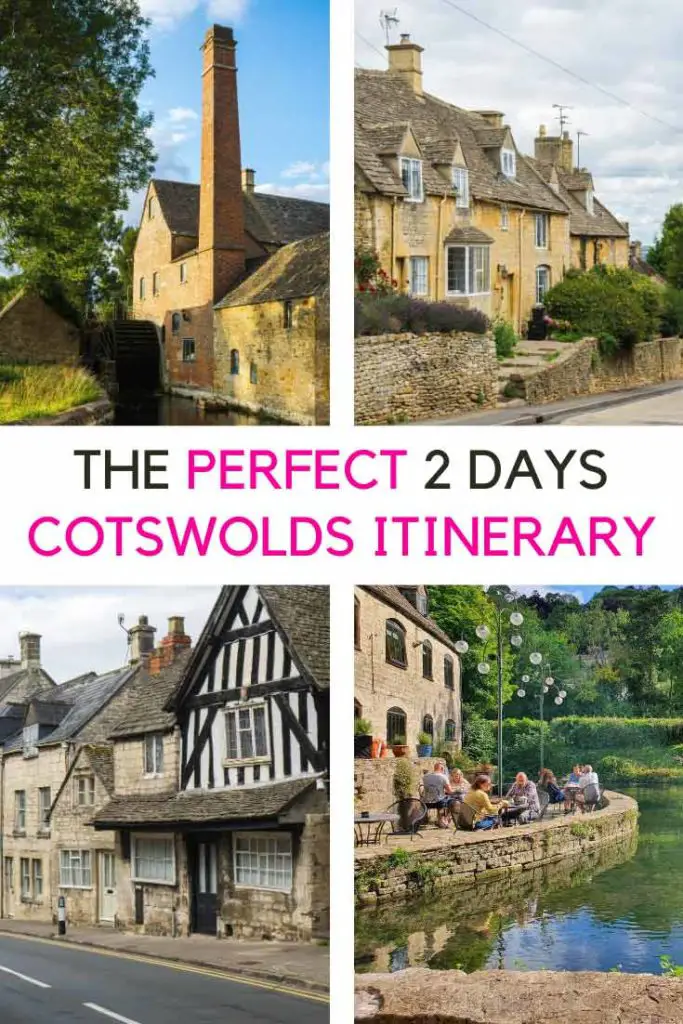
Disclaimer: Some of the links on this website are “affiliate links.” This means that if you click on the link and do a purchase, I will receive an affiliate commission at no extra cost for you. This helps me keep my website running and continue to share my traveling knowledge with you. I thank you for booking your flights or hotels using the links on my website. Regardless, I only recommend products or services I use personally and believe will add value to my readers.











Pingback: 17 of the Most Amazing UK Road Trips
Pingback: 12 Best Scenic Drives In UK To Plan Your Epic Road Trip Itinerary - Planet Hopper Girl
I love that you let us know that there wasn’t much to do in Nailsworth. Thank you for being honest and telling us to just look around. I appreicate that.